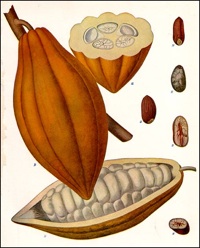Pre-Colombian Uses of Chocolate
Early colonial chroniclers recorded dozens of medicinal uses of chocolate among the Aztecs. It’s most common uses were for fattening up emaciated patients, for stimulating the nervous systems of apathetic or feeble patients, for improving digestion, and for masking unpleasant herbal ingredients. One chronicler warned that it “excites the venereal appetite,” a claim that undoubtedly boosted its popularity in Europe.
Current Research
 “Since well before its introduction to western consumers in the sixteenth century, cocoa and its most popular derivative chocolate have long been used as therapeutic and medicinal remedies,” wrote Steve Laning in Functional Foods & Nutraceuticals Magazine.
“Since well before its introduction to western consumers in the sixteenth century, cocoa and its most popular derivative chocolate have long been used as therapeutic and medicinal remedies,” wrote Steve Laning in Functional Foods & Nutraceuticals Magazine.
Over the last decade researchers have identified a number of medical benefits of chocolate, particularly dark chocolate. Many of these benefits are due to chocolate’s high flavonoid levels, as flavonoids act to tie up free radicals that trigger heart disease and certain functions associated with aging.
Specifically, chocolate’s benefits include:
- Acting as an antioxidant by reducing the oxidation of LDL, the bad cholesterol;
- Reducing blood clotting and may stabilize arterial plaque;
- Increasing blood vessel flexibility, which may help control blood pressure; and
- May be effective in preventing coughs, thanks to theobromine.
A good source for current research on the health benefits of chocolate can be found at www.chocolate.org.
Chocolate Myths
The Chocolate Manufacturers Association recently published a guide that dispels the following myths:
- Chocolate does not cause acne.
- Chocolate is not a common food allergen.
- Neither chocolate nor sugar causes attention-deficit hyperactive disorder in children.
- Chocolate is not a major contributor of caffeine in the American diet.
- Women who crave chocolate likely do so because of its flavor and mouth feel, not because there are “addictive” substances in chocolate.
- Neither cocoa nor unsweetened chocolate are intrinsically cariogenic. While any food that contains sugar or starch can cause dental caries, studies show chocolate may be actually less cariogenic than many foods.
- Chocolate does not trigger migraine headaches.
- There is no evidence that obese people consume more chocolate than normal-weight people.
Excerpted from: Chocolate Manufacturers Association, Chocolate Health: A Scientific Overview for the Health Professional.
General Interest Information
Chocolate History – CuisineNet Digest provides a helpful guide that provides a brief outline of chocolate history from 1500BCE to present time. Visit CuisineNet Digest’s timeline of chocolate events.
Glossary of Chocolate Terms – ChocolateSource.com provides a helpful glossary of chocolate terms from alkalinization to Xocoatl. Visit ChocolateSource.com’s glossary.
World Cocoa Producing Countries – A map indicating the countries producing fine & flavor, bulk or both beans.
From field to bar – The National Confectioners Association’s The Story of Chocolate website discusses the origins of cocoa and the communities that rely on it. The website is divided into four segments: “Where is it from?,” “What is it?,” “Who depends on it?” and “Savor it!”
Confectionery Associations
Fine Chocolate Industry Association – FCIA is the professional non-profit organization supporting the development and innovation of the fine chocolate industry and best practices. It was founded in 2005 by an international group of chocolate professionals who came together in support of the art of fine chocolate making.
International Cocoa Organization – The main goal of the International Cocoa Organization (ICCO) is the fostering of co-operation between cocoa producers, consumers and the trade and industry in all sectors. The ICCO is the main world forum for the gathering and dissemination of information on cocoa, for the promotion of cocoa research and studies of the economics of cocoa production, consumption and distribution and for the encouragement of development projects concerning cocoa.
National Confectioners Association – Founded in 1884 in Chicago by representatives of 69 confectionery manufacturing firms, the National Confectioners Association (NCA) is one of the oldest, most respected trade associations in the world.
World Cocoa Foundation – The mission of the World Cocoa Foundation is to promote a sustainable cocoa economy through economic and social development and environmental conservation in cocoa growing communities.
Other Organizations
ChocolateLife – TheChocolateLife is an on-line community for chocophiles, and aspiring chocophiles, to explore, learn, and share.
FairTrade USA – TransFair USA is a nonprofit organization and only third-party certifier of Fair Trade products in the United States, insuring that farmers and farm workers behind Fair Trade certified goods were paid a fair, above-market price. TransFair has introduced Fair Trade Certified cocoa, coffee, tea, fresh fruit, rice and sugar.
Organic Trade Association – The Organic Trade Association (OTA) is a membership-based business association that focuses on the organic business community in North America. OTA’s mission is to promote and protect the growth of organic trade to benefit the environment, farmers, the public and the economy.
Confectionery Publications
Candy Industry Magazine – Candy Industry is the leading information source for the global confectionery marketplace, from manufacturing to retailing.
Kennedy’s Confections – Kennedy’s Confection, based in the UK, is over 120 years old and one of the oldest trade magazines in the World. Kennedy’s have a wealth of information in the confectionery and food sectors dating back decades.
Manufacturing Confectioner – First published in 1921, the Manufacturing Confectioner is the business magazine of the global sweet goods industry marketing, manufacturing and management.










